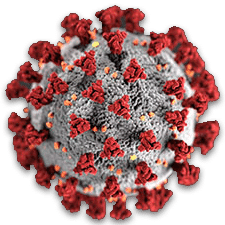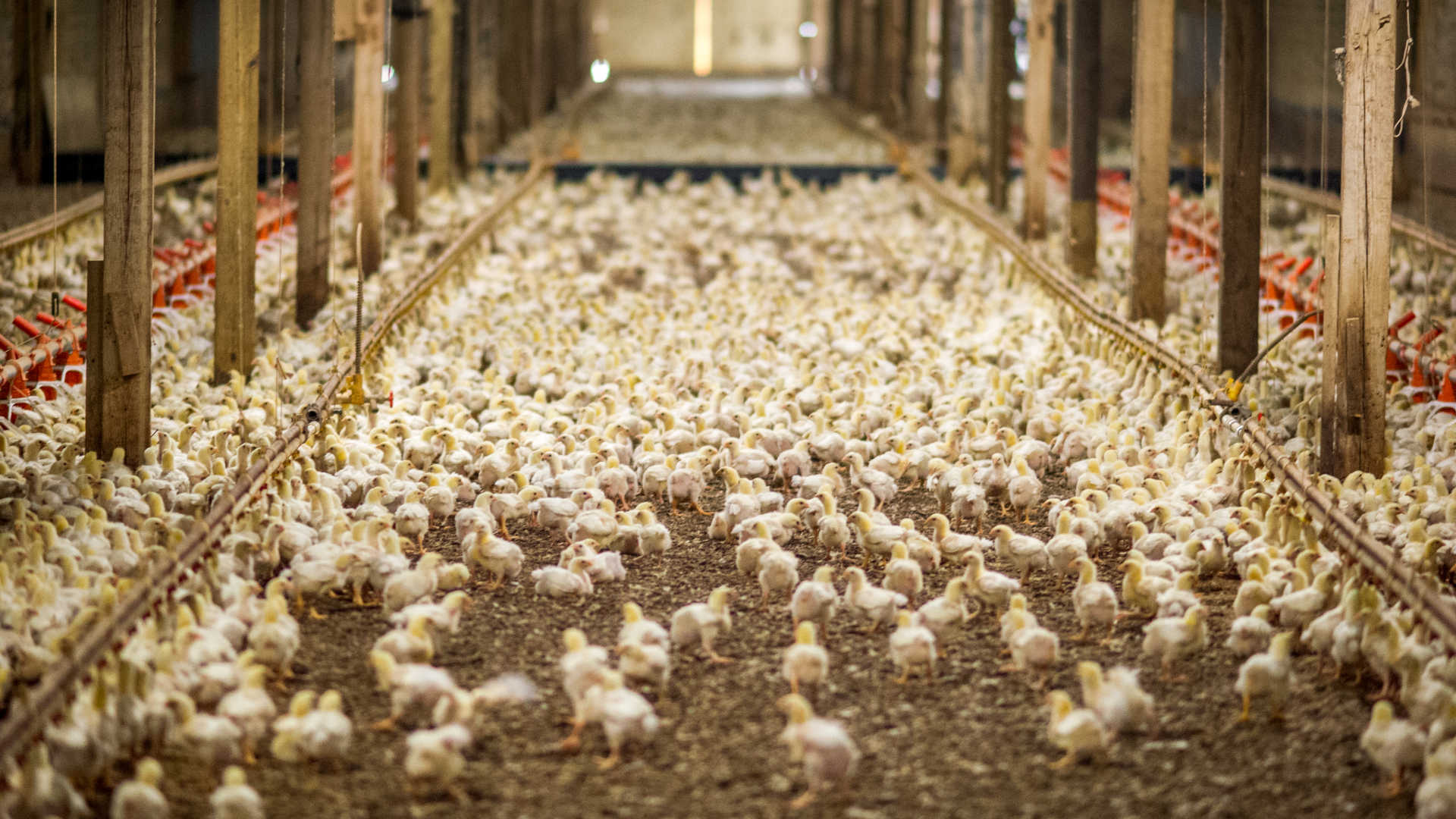The Egg Industry Grapples With a Grim Practice: Chick Culling
Every year, up to 7 billion day-old male chicks are tossed into shredding machines, gassed, or suffocated in plastic bags — a process known as chick culling. This grim ritual is underpinned by both biology and economics: Male chicks don’t lay eggs, and they fatten up too slowly to be sold as meat. Across the globe, culling has become the default strategy for the egg industry to eliminate the unwanted hatchlings.
“It is horrible. You see these puffy, newly hatched chicks on a conveyor belt,” headed toward a large blade that slices them “into a gazillion pieces,” said Leah Garcés, president of Mercy for Animals, an animal rights advocacy group in the United States. In recent years, local and international animal rights groups, particularly in France, Germany, and the U.S., have been ramping up pressure on governments and the egg industry to commit to ending the practice — particularly given technological innovations that allow producers to identify the sex of a developing chick before it hatches. The process is called in-ovo sexing, and such technologies, versions of which are already deployed in some countries, can obviate the need for live chick culling.
Nearly five years ago, United Egg Producers, an agricultural co-operative whose members are responsible for producing more than 90 percent of all commercial eggs in the U.S., released a statement pledging to eliminate chick culling by 2020, or as soon as a “commercially available” and “economically feasible” technology became accessible. That pledge was negotiated with the Humane League, an animal rights nonprofit organization. But 2020 has come and gone, and while UEP’s pledge wasn’t legally binding, some egg industry leaders and scientists say there is little sign that the industry is anywhere near phasing in cull-free technologies that could still meet the colossal supply of more than 100 billion eggs produced every year in the U.S.
Part of the reason for the sluggish pace of change, critics say, is that the U.S. has been investing in and nurturing the development of sophisticated cull-free technologies that, while promising, remain expensive and could take several more years to develop, scale, and deploy across the nation — particularly given that the Covid-19 pandemic has shuttered labs and otherwise slowed the pace of innovation. Meanwhile, a method of in-ovo sexing of eggs is already being used in Europe — though some American stakeholders say that method, which involves creating a tiny hole in the eggshell with a laser, is sub-par, because it increases the risk of contamination. European developers dispute this, however, and as of this year, cull-free eggs are available in thousands of supermarkets in Germany, the Netherlands, Switzerland, and France with only modest additional costs to consumers and hatcheries.
What’s clear is that as the hunt for a solution drags on, the U.S.-based culling continues apace. “I don’t like false promises,” said Michael Sencer, executive vice president for Hidden Villa Ranch, a California-based food company that owns egg and dairy subsidiaries. Sencer expressed support for UEP’s pledge, but he acknowledged, “They’ve supported a number of groups that said they could come up with the technology and nothing has happened.”
UEP declined to be interviewed by Undark and instead provided a press statement highlighting its continued commitment to end culling. “We remain hopeful a breakthrough is on the horizon,” Chad Gregory, president and CEO of UEP, said in the statement.
Whether U.S.-based producers could be nudged by critics to explore existing technologies rather than pursue new ones remains unclear, but both animal rights groups and industry leaders agree that chick culling is not only cruel — it is wasteful. “I mean, name another industry where 50 percent of the finished product immediately goes to the garbage can,” said Jonathan Hoopes, president of Ovabrite, a Texas-based startup developing an in-ovo sexing technique. Incubating male eggs also takes up unnecessary space, energy, and money, making a solution to culling in the interest of both animal rights activists and egg producers.
“Forgetting the ethics of not killing all those birds, look at the money saving,” said Sencer, who estimated that the industry could save billions of dollars with the right technology. “It’s mind-boggling.”
Since the 2016 statement, the largest funding initiative to eliminate chick culling has come from the Foundation for Food & Agriculture Research (FFAR), which launched the “Egg-Tech Prize” — a public-private research initiative that provides funding for scientists and startups seeking to develop in-ovo sexing technologies — with Open Philanthropy in 2019. Deploying such a technology would not only make chick culling obsolete, it would also allow the industry to repurpose unwanted male eggs for food, animal feed, or vaccine development.
In November of 2019, FFAR announced six finalists who received more than $2 million in total seed funding to develop sex identification technologies. Phase II of the competition will award up to $3.7 million for a single working prototype.
According to Tim Kurt, FFAR’s scientific program director, the deadline for submissions has been pushed back due to Covid-19 delays and is now scheduled for spring 2022. However, the foundation could also decide not to fund any of the teams if they are not satisfied with the timeline. That’s a prospect Tom Turpen, a contender for the prize, says is a real possibility, especially given that at least some of the teams — his included — have experienced setbacks since the start of the pandemic. With travel restrictions and university laboratories shut down, access to data, equipment, and supplies has made it harder for teams to make progress on particular aspects of their projects, says Kurt.
Finalists, who were awarded between $396,000 and $1.1 million dollars each include startups and research laboratories with big, out-of-the-box ideas. This includes Orbem, a German startup that sexes chicks by combining high-speed scanning of eggs with AI technology, and SensIT Ventures, Inc., a California-based company, which Turpen heads, that uses a microchip to sex chicks by identifying gases emitted by eggs early in development. The selection team specifically funded projects that could potentially upend the egg industry, says Kurt.
The technologies that were selected have “the potential to really transform the industry,” said Kurt, who was involved in the selection. “They might be a bit higher risk, but if they were successful, and our funding could help them become successful, they would really be the most ideal solution.”
 |
For all of Undark’s coverage of the global Covid-19 pandemic, please visit our extensive coronavirus archive. |
Kurt and other industry leaders are optimistic that some of these technologies will help eliminate chick culling in the near future, but others are less hopeful. Changing current practices, Sencer said, would require “billions of dollars of investment in new equipment. And it’s just not going to happen [quickly], it’s happening slowly.” Sencer added that he predicts the technology may be scalable towards the end of the decade.
Even researchers competing in the Egg-Tech Prize themselves admit that, while a sexing technology may be on the horizon, cull-free eggs won’t be scalable for at least two more years. Turpen says the biggest obstacle lies in developing a technology that is not only capable of rapidly and accurately sexing chicks, but is also readily affordable to consumers and hatcheries across the nation.
“You could do a lot of things to identify the sex of the egg. That’s not the point. The point is: Can you do it and still have eggs people can afford to eat?”
To avoid a surge in costs that would inevitably arise from suddenly adopting a new mode of production, Turpen says a more likely and more reasonable path to scaling this nationally would be a slow and incremental process. “The adoption and replacement of existing equipment — that’s going to look more like making the coal industry go away.” That industry “is going away,” Turpen said, “but it’s going to be a long time.”
Other researchers in the Egg-Tech Prize have also made it clear that an all-encompassing solution to culling is not around the corner. Benjamin Schusser, whose research with colleagues at the Technical University of Munich turned into the spin-off company, Orbem, declined an interview, saying “we don’t want to awake[n] hope that there is a solution almost ready for market.” Pedro Gómez, the CEO and co-founder of Orbem said in a 2019 interview with Germany’s Federal Ministry for Economic Affairs and Energy, that they hope to “classify one billion eggs per year by 2025.”
Given the mismatch in expectations, some are baffled by UEP’s ambitious commitments to stamping out culling. Hoopes says the industry has made similar pledges in the past and they failed to yield tangible results.
But David Coman-Hidy, president of the Humane League, considers the progress in research and development since 2016 a “major win,” and credits the UEP pledge with heightening awareness about a cruel and largely unheard-of practice while bolstering innovation in in-ovo sexing technologies. In fact, the Humane League saw the 2020 goal as somewhat flexible, says Coman-Hidy. “Back then, it was such early days, we didn’t know how quickly or how many companies would get involved or what the research would look like.”
Meanwhile, commercially viable, in-ovo sexing technologies already exist in Germany and France. And Germany is poised to become the first country to ban industrial culling of male chicks, after the government approved a draft law to end the practice from 2022 onwards.
Currently, a company based in Germany and the Netherlands called respeggt GmbH uses in-ovo sexing by creating a tiny hole into the egg using a laser, extracting fluids, and sexing the chick by testing for specific hormones, explains Kristin Hoeller, head of business development and public affairs for respeggt. The technique, known as Seleggt, is based on research by scientists at the University of Leipzig and further developed in collaboration with REWE, a German supermarket chain, and HatchTech, a Dutch technology company specializing in incubation and hatchery equipment.
The method can sort chicks on the ninth day of development, when it is “exceptionally unlikely” that chick embryos experience any sensations whatsoever, David Mellor, professor emeritus of animal welfare science and bioethics at Massey University in New Zealand, wrote in an email. This is a crucial detail given that chick embryos have the capacity to experience pain at later stages of development. A procedure that might cause harm, such as using the male egg for food or vaccine development, may simply be shifting the cruel practice to an earlier stage, says Peter Singer, an animal rights advocate and professor of bioethics at Princeton University.
Using this method, respeggt now has cull-free eggs in more than 6,000 supermarkets across France, Germany, Switzerland, and the Netherlands, with hopes to expand further. They have also devised a ready-to-implement business strategy for producing commercial cull-free eggs. Hatcheries won’t have to invest anything, Hoeller said. Instead, costs will be passed onto centers where eggs are packed into cartons for commercial distribution. These packing stations will have to pay a license fee of around 2 Euro cents, about the same in U.S. currency, per egg. While respeggt plays no role in how supermarkets price eggs, the cost to consumers ranges between 2 and 5 Euro cents more per respeggt egg than regular ones.
Many U.S. experts, however, are concerned that creating a hole in the eggs could pose a serious food safety risk, given that it increases the chances of contamination from external sources. “It’s a risk that I think the industry would rather not take,” said Turpen. Kurt echoes this, saying that all finalists explicitly use non-invasive techniques to avoid this possibility. Focusing on non-invasive techniques also means they can be more easily repurposed for other scientific endeavors, such as vaccine development, he adds.
Hoeller disputes the suggestion that their technology poses an infection risk. “The perforation of the eggshell with the laser has no negative results at all,” she said, adding that the hole is so small it actually closes itself naturally within 30 minutes.
To be sure, some animal rights groups suggest that quibbling over a technological solution distracts from what they see as the real problem at hand: the egg industry itself. “Instead of putting a Band-Aid on a Band-Aid on a Band-Aid and trying to fix all these problems with more technology and more technology, here’s another idea: Why don’t we do plant-based eggs?” said Garcés. She and other animal rights activists point to food waste, animal suffering, and health-associated costs as reasons to divest money away from the egg industry to support companies that produce plant-based alternatives.
Short of that, though, other non-invasive egg sexing technologies have also been developed in Europe. Prior to the coronavirus pandemic, and amid pressure by the French government to ban culling by the end of 2021, Carrefour supermarkets planned to launch their first round of cull-free eggs on May 1, 2020. However, experts note that this technology sexes chicks on the 13th day of development, a period where the chick fetus may experience pain. Anticipating these criticisms, the German company behind this technology, Agri Advanced Technologies GmbH, a subsidiary of EW Group, is currently developing another technology aimed at determining the sex of chicks on the fourth day of development.
While imperfect, Hoopes suggested that the existence of viable, up-and-running technologies in Europe raises questions about why the U.S. is taking a slower, more ambitious approach. But other experts speculate that the technologies being pursued in the U.S. may ultimately prove cheaper and more flexible in the long run. “You would think the simplest method of doing this would be the best,” said Singer. “But maybe for very large producers, the investment is worth it. Maybe it pays off in saving labor costs or other costs.”
At this point it’s not clear what the best strategy to eliminate culling is yet, says Singer, but he believes there is a moral imperative to at least try and stamp out the practice from hatcheries around the globe. It’s also important to continue to pressure the industry to change, he said, but change will require not only perseverance, but patience. “These things,” he said, “will take some time.”
Jonathan Moens is a freelance journalist based in Rome. His work has appeared in Yale Environment 360, Inside Climate News, and Spectrum.












Comments are automatically closed one year after article publication. Archived comments are below.
The Philippines would welcome and appreciate your selling your male chick eggs to them to make their delicacy.
I was reading The Omnivore’s Dilemna when it came out, thought I understood all the “factory farming” issues, did not understand this one until Undark. This site is an amazing resource.
I have been trying to learn about this issue and this was a very informative article. Thank you!
If people would only show as much concern about killing human babies with abortions being allowed in so many countries. Abortion is just another name for murder or infanticide. Who cares about chicks?
There are many different belief systems that oppose human abortion, but most of them also oppose waste of natural resources and cruelty to living things. My own religion makes it clear that God cares about men — but also about the birds. It’s not either/or.
“29 Are not two sparrows sold for a penny? Yet not one of them will fall to the ground outside your Father’s care.[a] 30 And even the very hairs of your head are all numbered. 31 So don’t be afraid; you are worth more than many sparrows.”
Simple solution……go vegan!!
This is a grisly & inhumane practice, disrespectful to the honor of our living food supply. It perpetuates disassociation from the act of killing livestock, which must always honor the lives taken. Shame on us for such wastefulness.
Well said.